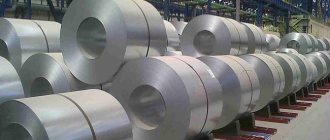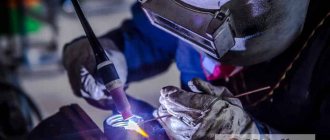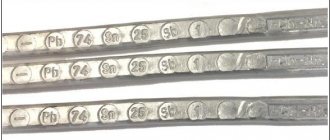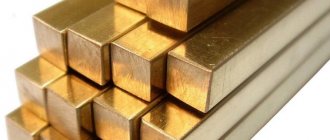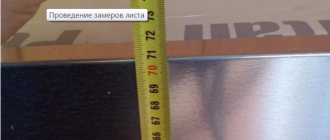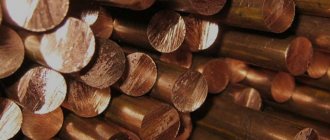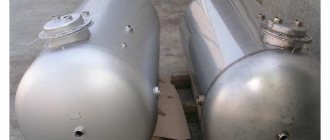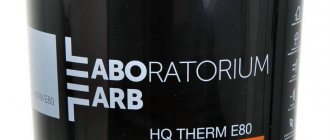Physical and mechanical properties of copper
Copper is a red-pink metal with a golden tint, occupying 29th place in the table of chemical elements and having a density of 8.93 kg/m3. The specific gravity of copper is 8.93 g/cm3, the boiling point is 2657, and the melting point is 1083 degrees Celsius.
This metal has high ductility, softness and ductility. Having high viscosity, it is excellent for forging. Copper is a fairly heavy and durable metal. In its pure form, it conducts heat and electricity well (second only to silver).
Chemical properties of metal
Chemical characteristics, as well as mechanical, magnetic and physical properties such as ductility, viscosity, specific gravity of copper, are of current importance. The metal has low chemical activity. At low humidity and normal temperature it has high corrosion resistance. When heated, it oxidizes, forming oxides. In a humid environment containing carbon dioxide, the copper surface becomes covered with a greenish film containing metal oxide and carbonate. Copper reacts with halogens to form salts at room temperature. Easily interacts with sulfur and selenium. It dissolves perfectly in nitric and heated concentrated sulfuric acid. Without access to oxygen, it does not react with dilute sulfuric and hydrochloric acid.
Useful tips
In conclusion, here are a few tips that should be taken into account when organizing wiring:
- In case of independent design of wiring in a house or apartment, it is better to choose copper wires. With a smaller cross-section, they can withstand greater currents and are more resistant to frequent bending. An equally important point is volume. Copper wires are compact, which simplifies the process of creating grooves. For example, when connecting a receiver with a power of 7-8 kW, the aluminum wire should have a cross-section of about 8 mm. The cable has three cores plus a braid. As a result, the total diameter is about 1.5 centimeters. For comparison, copper can have a cross-section of 4 sq. mm, and the overall diameter is no more than a centimeter.
- When installing a socket, a three-core cable with a ground wire must be used. The distance of the socket from the floor is 30 cm. When organizing a lighting circuit, it is allowed to use cables with two cores (grounding is not needed here).
- It is forbidden to hang the entire load on one pair of wires (especially if they are aluminum). The best option is to divide the circuit into several lines. For example, a bathroom is powered through one machine, lighting through another, a kitchen through a third, and so on. The wire cross-section for the kitchen and bathroom should be 4 or 6 sq. mm, and for the lighting circuit - 1.5 or 2.5 mm.
The most difficult situation is in old apartments where aluminum wires are installed, which have outlived their useful life and require replacement. Wiring with a cross-section of 2.5 sq. mm can withstand a load of no more than 20 Amps, which is not enough for modern electrical receivers. In addition, the insulation of the wires loses its elasticity over time and gradually deteriorates. In such a situation, the only solution is to completely replace the wiring with copper wires.
For more information on why it is worth replacing aluminum wiring with copper in an old house, watch this video:
Copper Density
The value of this value, contained in a special table, is 8.93*103 kg/m3. The specific gravity of copper is an equally important quantity characterizing the metal. It is, as already mentioned, 8.93 g/cm3.
It turns out that the values of the density and specific gravity parameters for a given metal coincide, which is not typical for other materials. The weight of the product made from it depends on the density of the material. To calculate the mass of a future part, specific gravity is usually used rather than density.
Specific gravity of metal
This value, like density, is an important indicator of various materials, which is determined using available tables. Based on the specific gravity of copper and its alloys, it is possible to advantageously select the appropriate metals for the manufacture of a product with the given parameters. Such calculations are usually carried out at the design stage. Specific gravity as a physical quantity is calculated by the ratio of the weight of a substance to its volume. This quantity should not be confused with density, like mass with weight. Knowing the specific gravity of copper or an alloy, you can always calculate the mass of a product made from this material.
Which wiring material is best?
Now let's look in more detail which wire is better, copper or aluminum. In this regard, many stereotypes and misconceptions have appeared, which we will discuss below:
- Durability. It is believed that the lifespan of copper wire is longer than aluminum. This is a misconception. If you look at a special reference book, you can make sure that the service life of cables made of both types of metal is identical. For products with single insulation it is 15 years, and for products with double insulation - 30.
- Tendency to oxidation. When using an aluminum cable, it is worth remembering its tendency to oxidative processes. Back in school, we were told that Al (aluminum) is a metal that actively interacts with oxygen, which is why a thin film appears on its surface. The latter protects the metal from further decay, but impairs its conductivity. If the wire is isolated from the environment, the risk of oxidation processes is minimized. The best option is to use special terminal blocks with conductive paste. The peculiarity of the latter is to improve the quality of the contact connection between two wires and remove the oxide film from the metal. In addition, a special lubricant prevents aluminum from coming into contact with the surrounding air.
- Strength. Copper wiring is considered more durable and can withstand repeated bending. GOST states that a wire made of copper must withstand 80 kinks, and one made of aluminum - 12. If the wiring runs in the wall, floor, or is hidden under the ceiling, this feature is not so important.
- Price. The price of aluminum wire is 3-4 times lower. But when choosing, it is important to remember that a copper wire with a cross-section of 2.5 sq. mm is designed for a current of 27 Amperes. If you give preference to aluminum wiring, the thickness of the wire should be 4 square meters. mm (rated current 28 Amps).
- Resistance. When deciding whether to choose aluminum or copper wires, it is worth considering different resistivities. For copper, this parameter is about 0.018 Ohm*sq.mm/m, and for aluminum - 0.028. But it is worth considering that the total resistance (R) of the conductor depends not only on the mentioned parameter, but also on the length and area of the conductor. If we take into account that aluminum wires of a larger cross-section are used for the same load, the final R of copper and aluminum products will be approximately identical. The greatest resistance occurs at the joints, but if you follow the tips discussed above, you don’t have to worry about this.
- Ease of installation. It is believed that connecting aluminum wires is a more difficult task. This is only relevant for the usual connection of wiring, by twisting. In the case of using end caps, terminal blocks or bolts, this problem disappears.
A situation involving contact between two different metals deserves special attention. When copper and aluminum combine at the point of contact, various processes occur, due to which the resistance increases. As a result, the junction of the two wires overheats, the insulation is destroyed and the risk of fire increases.
The feature discussed above is characteristic of all metals having different resistivities. In addition, many manufacturers do not use “pure” metals, but their alloys, which also leads to a change in the resistance parameter. To avoid problems in the future, it is better to connect the wires correctly and avoid twisting them.
Main copper alloys used in industry
According to the manufacturing process, copper alloys are divided into cast and wrought, and depending on the chemical composition - into bronze and brass. In the latter, the base is copper and zinc, and other elements can be added. Bronze is an alloy of copper (specific gravity 8.93 g/cm3) with other metals. The choice of alloying component depends on the specific use of the product.
Based on the content of the main component, copper casting is of the following types:
- Tin bronze. During production, hardening and aging are used to increase ductility and strength.
- Aluminum bronze. It has anti-corrosion properties and is perfectly deformable.
- Lead alloy. Has excellent anti-friction properties.
- Brass. May consist of two or more components.
- A copper-nickel alloy containing zinc. Its properties and appearance resemble cupronickel.
- An alloy of copper and iron. Its main difference is high porosity.
Technical indicators of metal alloys
The most common copper-based alloys are brass and bronze . Their composition is also formed from other elements:
- zinc;
- nickel;
- tin;
- bismuth.
All alloys differ in structure. The presence of tin in the composition allows the production of bronze alloys of excellent quality. Cheaper alloys include nickel or zinc. The produced materials based on Cuprum have the following characteristics:
- high ductility and wear resistance;
- electrical conductivity;
- resistance to aggressive environments;
- low coefficient of friction.
Copper-based alloys are widely used in industrial production. They are used to produce dishes, jewelry, electrical wires and heating systems. Materials with Cuprum are often used to decorate the façade of houses and make compositions. High stability and ductility are the main qualities for the use of the material.
Specific gravity of electrical copper
This is how it turns out after purification from impurities. The smallest content of any metals in it significantly reduces its electrical conductivity. For example, a content of 0.02% aluminum reduces conductivity to 10%, despite the fact that this metal conducts electricity well. The most important characteristics of the material are:
- specific gravity of copper;
- electrical resistance;
- melting temperature.
For the needs of electrical engineering, technically pure metal is used, which contains from 0.02 to 0.04% oxygen, and products with high current conductivity are made from special, oxygen-free copper. For electrical products (transformer windings, wires, cable cores, electrical busbars) different types of metal are used.
Advantages and disadvantages
Aluminum wiring has the following advantages:
- Small mass. This feature is important when installing power lines, the length of which can reach tens or even hundreds of kilometers.
- Affordability. When choosing a material for wiring, many are guided by the cost of the metal. Aluminum has a correspondingly lower value, which explains the lower price of products made from this metal.
- Resistance to oxidative processes (relevant in the absence of contact with open air).
- Availability of protective film. During operation, a thin coating forms on aluminum wiring, protecting the metal from oxidative processes.
Aluminum also has a number of disadvantages that you need to be aware of:
- High metal resistivity and tendency to heat. For this reason, the use of wires smaller than 16 sq. mm is not allowed (taking into account the requirements of the PUE, 7th edition).
- Loosening of contact connections due to frequent heating when passing a heavy load and subsequent cooling.
- The film that appears on an aluminum wire upon contact with air has poor current conductivity, which creates additional problems at the junction points of cable products.
- Fragility. Aluminum wires break easily, which is especially important when the metal frequently overheats. In practice, the service life of aluminum wiring does not exceed 30 years, after which it must be replaced.
The use of copper and its alloys in the national economy
High strength, specific gravity of copper, excellent electrical conductivity, good machinability - all this allows it to be used in many areas of production:
- Construction - goes well with brick, wood, glass, stone. Has a long service life and is not afraid of corrosion.
- Electrical – wires, cables, electrodes, buses.
- Chemical – produce parts for equipment and tools.
- Metallurgical – production of alloys. The most popular is brass. It is harder than copper, can be forged well, and has toughness. It is stamped into various shapes and rolled into thin sheets.
- Artistic – copper coinage, bronze statues.
- Household - used for making dishes, pipes.
Copper ores
Under natural conditions, copper is most often found in compounds, but it can also be found in the form of nuggets. Minerals that are its main sources include:
- Cuprite is an oxide group mineral.
- Malachite - known as an ornamental stone, contains copper carbonate. Russian malachite, a carbonated copper green, is very popular.
- Azurite is a blue mineral, often fused with malachite, and has high hardness.
- Copper pyrite and copper luster - contain copper sulfide.
- Covelline is a sulfide rock that was originally discovered near Vesuvius.
Copper ores are mined mainly by open-pit mining. They may contain 0.4-1.0% copper. In terms of its production, Chile is the world leader, followed by the United States of America, Russia, Canada, and Kazakhstan.
Basic information about copper
Copper is the most common non-ferrous metal. It received its name in Latin - Cuprum - in honor of the island of Cyprus. It was mined there by the ancient Greeks thousands of years ago. Historians even came up with the Copper Age , which lasted from the 4th to 5th centuries BC. e. At that time, people made from popular metal:
- weapon;
- dishes;
- decorations;
- coins.
In the table D.I. Mendeleev, it ranks 29th. This element has unique properties - physical, chemical and mechanical. In ancient times, copper could be found in the natural environment in the form of nuggets, sometimes of very large sizes. People heated the rock over an open fire and then cooled it sharply. As a result, it cracked, which made it possible to restore the metal. This simple technology made it possible to begin the development of a popular element.
